In the Moscow metro anniversary - 75 knocked
 Bashny.Net
Bashny.Net
For general use the Moscow Metro was opened on May 15, 1935 at 7 o'clock in the morning. The movement started from the station "Sokolniki" to the station "Okhotny Ryad" and further along the branching - to the station "Park Kultury" and "Smolenskaya". 13 beautifully executed and richly decorated architectural stations-palaces, filled with streams of light, hospitably opened the doors to the working people of Moscow and the whole country.
People were up all night at the lobbies to be among the first passengers. Change machines and turnstiles was not there. Passengers with tickets were passed in two colors. Red give the right of way to the station "Sokolniki", yellow - back. For tickets to make notes about the time of issuance. The ticket is considered valid for 35 minutes. However, travel outside Moscow time and was not required - the length of the first track composes 11, 6 km.
Let's take a walk through the tunnels and stations of the first stage. It is not my task to show you the architectural beauty of these plants - and so it you already know. I want to tell you about the artifacts of reconstruction or just about unusual things that I have met during the filming.
30 Photo © russos
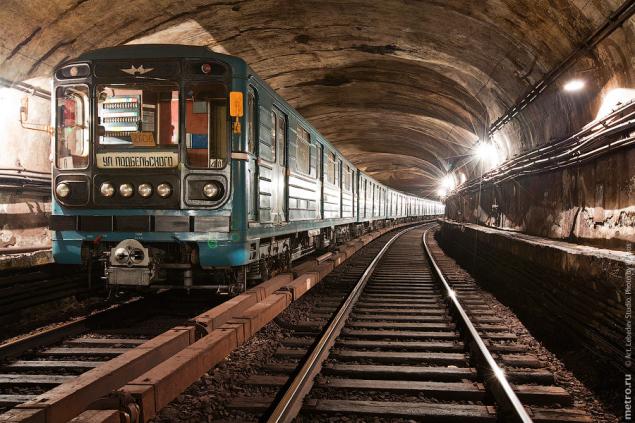
Deadlocks for the station Sokolniki
Since street Strominka forms at this point a steep bend and did not allow construction of puffins build a second main path along the axis of the way of the station, then by following from "Sokolniki" to "Transfiguration Square" follow train (a rare event for Moscow) with a deviation of the arrow. It is difficult to say whether to use the second in 36 main road, but now we have an unusual configuration deadlocks.

Station "Sokolniki»
At the end of the station are all sorts of service carts for service ceiling and walls. For example, here's the clever design is based on the platform and on the track. A turret can be moved along the guide rails.
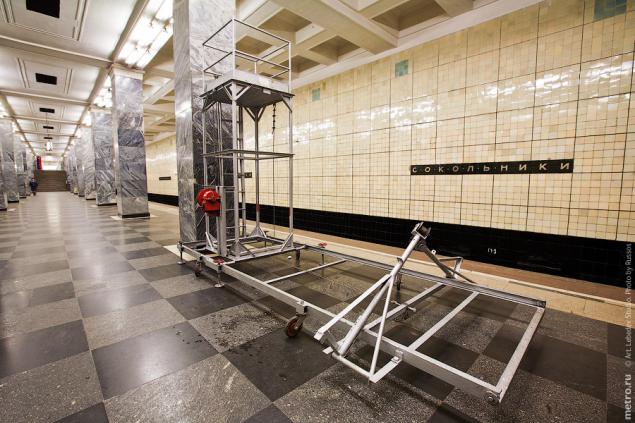
Driving "Sokolniki" - "Krasnoselskaya»
The first tunnel of the Moscow subway. The same experimental plot of penetration with a set of rubble. To the left of the opening three zabutovany first mines under construction Metro No. 29. It is for some time been used for natural ventilation, and it remained the number 175. Then built (it is seen more aperture) HS №174, where VOMD installed, and the first VSH zabutovany, retaining its top kiosk that after the construction of another business center has been moved to a new location, and a plaque to him was lost.

Station "Krasnoselskaya»
The peculiarity of the structural schema "Krasnoselskaia" is the location of the columns in a row along the axis of the station, rather than two, as in other similar plants of the first stage. On "Krasnoselsky" I do not forecast a large passenger traffic, so the platform is made narrower. Also right in the station for travel serёdke wall beyond VS №170.
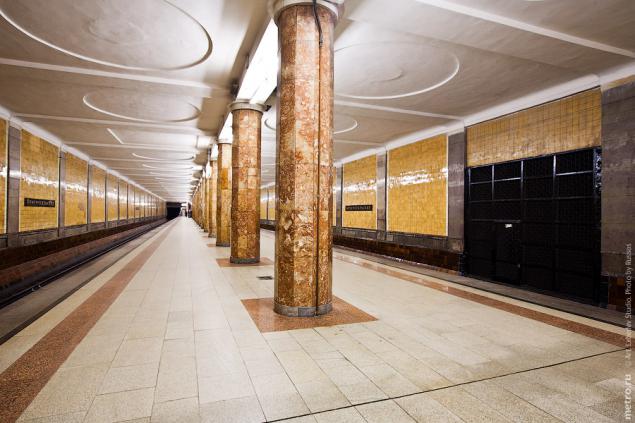
Driving "Krasnoselskaya" - "Komsomolskaya»
Night alignment in tight corners of the station "Komsomolskaya". III station the way is always free, as it is carried out by connection to the depot "North."

A branch of the depot
The portal of the tunnel at the depot "North."
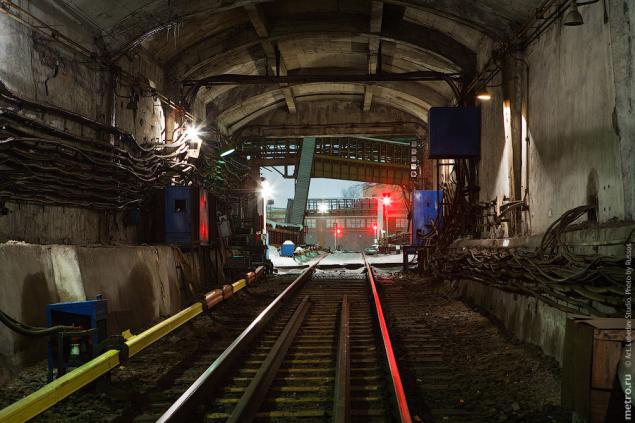
The station "Komsomolskaya»
Station design is unique. To serve a large number of passengers station was designed with passing over the tracks along the buildings balconies, which contributed to a more even distribution of passenger traffic. The width of the station platform level - 16, 8 meters, at balconies - 23 meters. Wide stairs connect the ends of the platform to the lobby. In addition, the station is arranged in the center of the transition bridge between the balconies and staircases to descend to the platform. Overlapping rests on four rows of columns, two rows on the platform portion and one on each of the balconies. Initially, passenger traffic at the station were neatly divided: incoming passengers heading to the balcony and down to the station in the center, go up the mechanical stairs. When the guards were removed, there was pandemonium on the stairs.

Driving "Komsomolskaya" - "Red Gate»
The rail car suddenly drove past. If you look at the ceiling, you can see the border between the two areas. Near us we build mining method, and in the construction of long-distance were using caissons. Ie three sections of tunnel were built on the surface, and then lowered to the design depth.
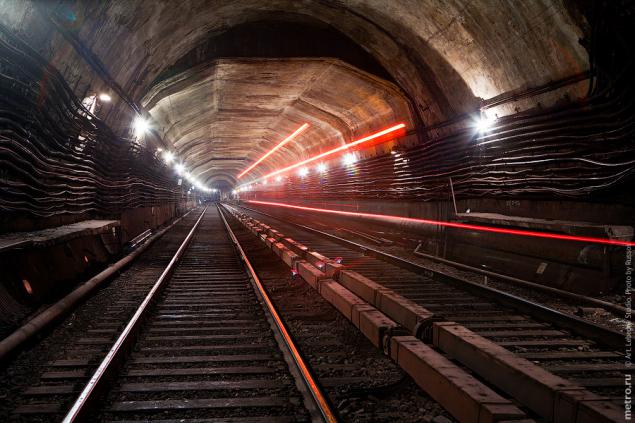
The station "Red Gate»
In 50 years at the station (as well as in the whole of the first stage) The hermetic locks were installed, resulting in the elimination of two pairs of passes between the side and middle rooms. In the picture you can see the two halves of the gate before closing.
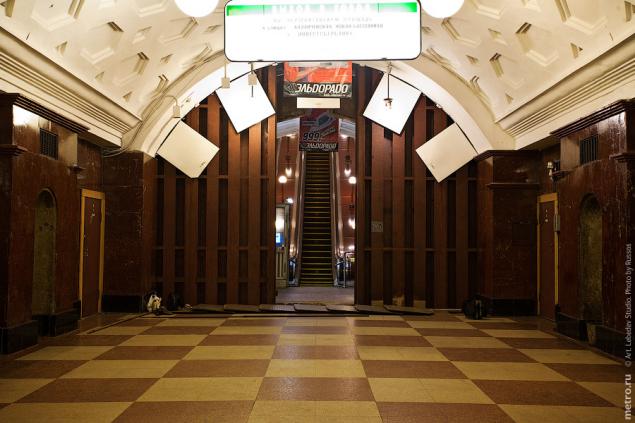
Driving "Red Gate" - "Pure ponds»
For the first phase is characterized by such coupling tunnels and approach ventkanala of mine - round and small.
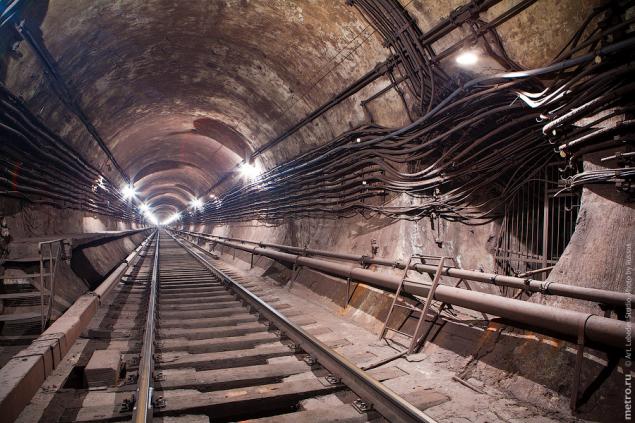
Station «Chistye Prudy»
During the Great Patriotic War at the station housed offices of the General Staff and Air Defense. The trains did not stop, the platform was cordoned off by passing trains plywood boards and in front of escalators Anteroom reinforced concrete wall was installed to extinguish a shock wave in the case of falling bombs. During the first two months of the war, has not yet been completed and construction work in the new silo to the General Headquarters, studies of Stalin and the Chief of General Staff Shaposhnikov located in underplatform spacing and stations from the first track. The remaining underplatform spacing and the second track and the platform used for and how communication node. When the stopped train traffic, before removing the voltage from the contact rail to the platform first way was fed up, cars which were used for both work and leisure. Furthermore, this compound tunnel to eliminate clogging any unforeseen situations.
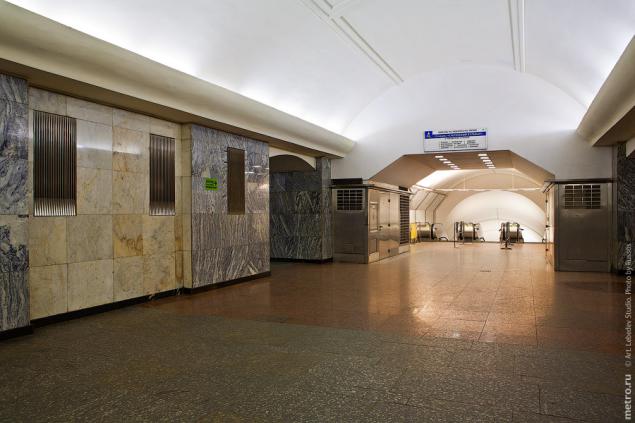
Driving "Pure ponds" - "Lubyanka»
Builders started construction on the original site dvuhsvodchatoy station. In order to provide a more powerful cover of Jurassic clays that can protect against the quicksands, vaults Deepen station about 3 meters. By changing the way work is primarily constructed vaults. Already leaving the meeting of the Moscow Committee, each metrostroevtsev saw before him quite a clear picture of the work and knew his place in it.
Quote from the book "How do we build a subway" M .: History of mills and factories, 1935. (Full story about the head station "Dzerzhinsk" (now the "Lubyanka") you can read here.
This book I have read for a long time - approximately in 2000-2001. And in January 2003, I was riding in the cab of Sokolniki line and saw that when following from Chistye Prudy tunnel has a strange configuration in the vicinity of the KGB. At some point, he converted from a round in a horseshoe-shaped, and the roof becomes a few meters higher than necessary. Then a set does "step" and it becomes normal. Apparently, this is a consequence of changes in the project. Ie when the decision was taken to burial station "Lubyanka", the tunnels on the Net ponds have been constructed as a whole. Therefore it was necessary to reconstruct the constructed area to lower the tray to the desired mark.

The station "Lubyanka»
Because of the complex geological conditions of the station was built without a central hall. At some point there was a question, and whether it is necessary to build a plant here, but this is declared inadmissible. At the cost of tremendous efforts, in fierce fight with underground elements, the station was built in the period, although without the central hall. In the 70s it was completed, but the architectural design has been radically changed. It is believed that it was many times worse and homely than it could be. In memory of the original form at the ends of travel station tunnels to keep the old design.
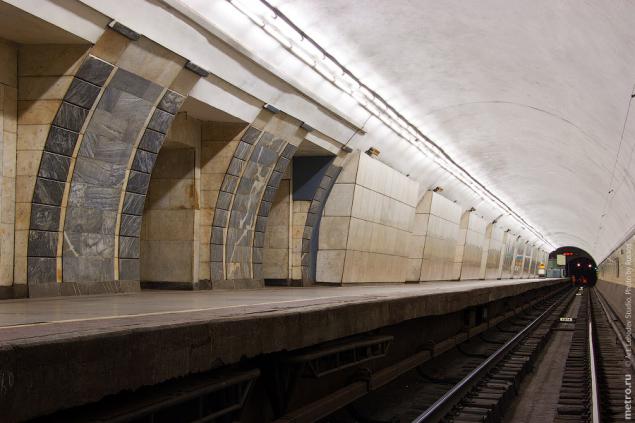
Driving "Lubyanka" - "Okhotny Ryad»
Metal structures or so-called hermetic locks. It was established after the war. Ie initially in the first place they are not becoming, but was subsequently held total reconstruction of stations and spans to install shutters.
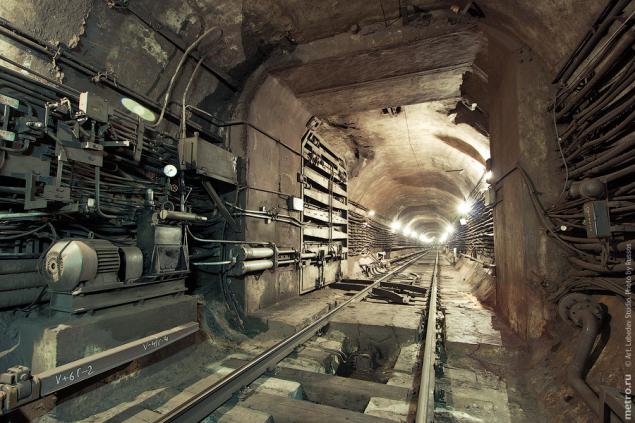
The station "Okhotny Ryad»
The basis of the method adopted was the development of the station put the so-called "German method." Originally constructed the wall, and then they were planted vaults station. First there were the extreme wall erected along the building of the hotel and home service stations. These barriers have separated all forthcoming work on buildings, protected bases from possible displacement of soil. Once the foundations were built for future piers and pylons themselves. The walls were built not continuous arrays and small parts, which are then connected to each other to prevent simultaneous disclosure of large volumes of voids in the heart of the city. All underground space was dissected countless galleries with a total length of several kilometers. For the first time the station has been used outside Okleechnaya insulation, which was later spread across the track.
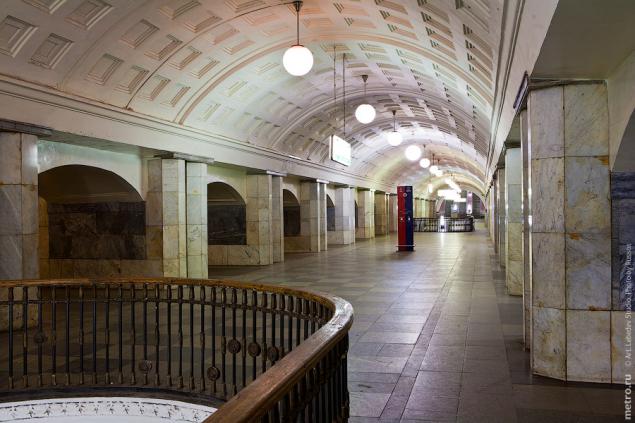
Driving "Okhotny Ryad" - "Lenin Library»
At Sokolniki line utility branch (CER) Alexandrovsky Garden consisted of two ways in the two tunnels. They were built to launch the first phase in 1935. In the mid-90s during the construction of the shopping center "Okhotny Ryad" under the Manege Square, it was decided to disassemble one tunnel that branches off on the way II, as he found himself in the body of the shopping complex. Turnouts were dismantled, but the camera stayed Congresses.
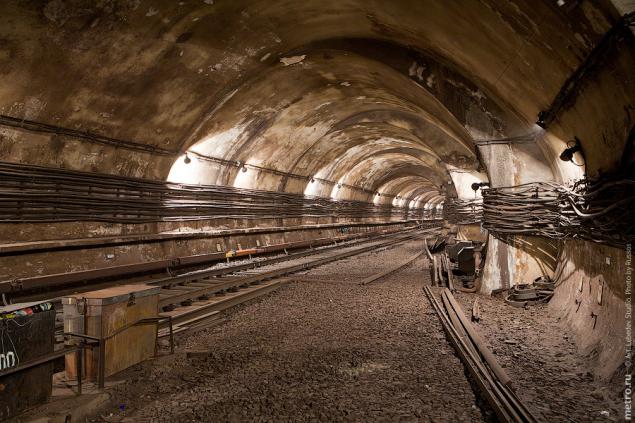
The station "Lenin Library»
The only station in the first stage, built vaulted. The choice of the type of plant affected as the ground conditions, and the need to make the work of the closed method, so as not to disrupt traffic. The station was built in extremely cramped conditions due to the small width of the passage between the houses that require the smallest width of the underground workings. According to unverified information, shortly after the opening on the platform it was a parquet floor, but it lasted a very short time.

Driving "Lenin Library" - "Kropotkinskaya»
Vibration Mount was established several years ago to protect the Museum of Fine Arts from vibration. On the right photo you can also see ventshahtu and fan. It was he scared buzzing at the entrance to Kropotkin with the reversal of the Library. Rather, it was built later, in the reconstruction of ventilation throughout the first phase.

Station «Kropotkinskaya»
For a long time the station was only one way in ground lobby on Gogol Boulevard, erected by the architect SM Kravets. The lobby is easy semicircular building of a series of circular columns in the form of an arch, which opens the entrance to the Gogol Boulevard. A wide granite staircase leads to the ticket hall, whose walls are lined with marblitom (glass plates milky). Unfortunately, the ticket hall has not escaped the barbaric replacement of wooden frames with plastic windows.
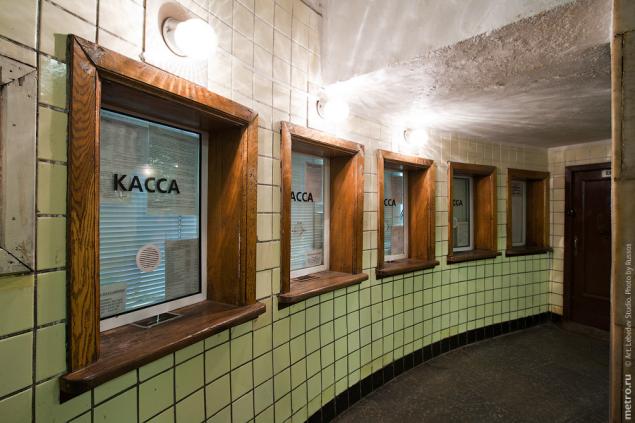
Driving "Kropotkinskaya" - "Park of Culture»
A typical two-way tunnels fine bedding.

The station "Cultural Park»
March 29th, 2010 at the station "Lubyanka" and "Park Kultury" Sokolniki line was exploded two suicide bombers. The blast killed 40 people and injured 88. Even a week later at the station carrying flowers.

Deadlocks for the station "Park Kultury»
Corner safety.

The service branch "Okhotny Ryad" - "Alexandrovsky Garden»
Left out of CERs on the I path of Sokolniki line. Next was the shooter and the only blind intersection on the main routes in the Moscow metro. The tunnel led to the way the SL II. Next, double-track tunnel turns into two single-track and leads to the station "Revolution Square."
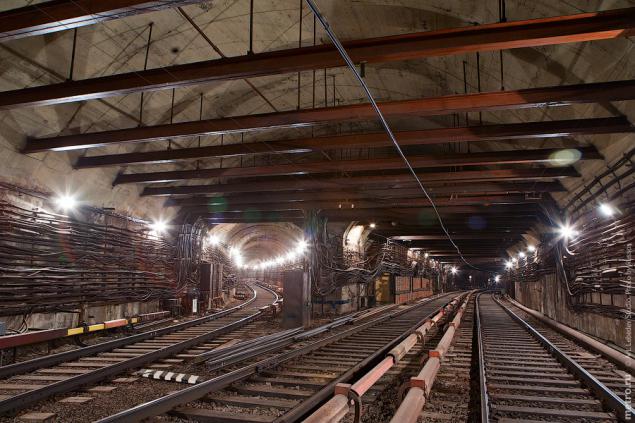
The station "Alexandrovsky Garden»
The station is unusual for the Moscow subway side-boarding platforms. This is explained by tracing tunnels in the narrow space between the Manezh building and Kutafia tower of the Kremlin. In the original draft of the first stage all the stations were designed with an island platform. But here, at the walls of the Kremlin, to accommodate the island platform would require dilution tunnels that would cut into the foundations of an arena and Kutafia tower. The slightest residue Manezh would violate the unique trusses. At the urging of Professor oversaw the construction of VL Nicolai and categorical demand commandant of the Kremlin, is responsible for the safety of the walls and towers, the project has been changed, the station adjacent to the path laid in a double-track tunnel. In the picture are the same mysterious tunnels, which, as many believe, lead to the Kremlin.
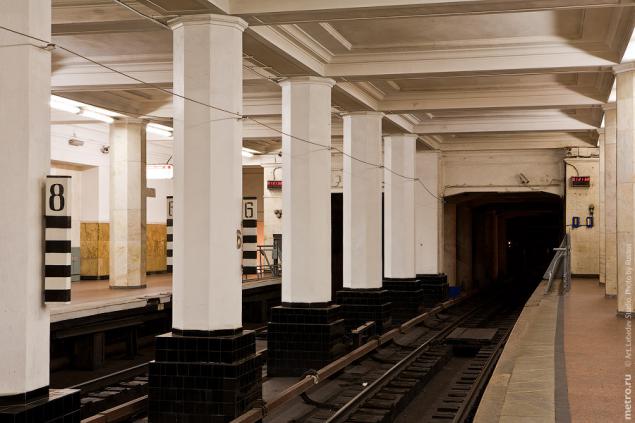
Driving "Alexandrovsky Garden" - "Arbat»
Cross Congress and VSH №350
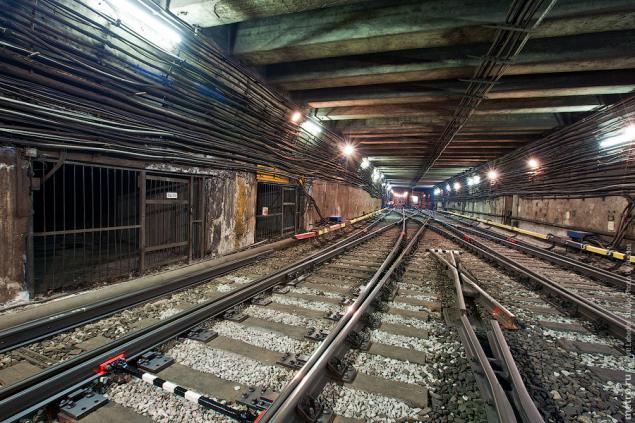
The station "Arbat»
In 1953, simultaneously with the opening of deep Arbat radius (of the Arbat-Pokrovskaya line), small radius from the station Arbat "Street. Comintern "(now" Alexandrovsky Garden ") to the station" Kiev "was closed. The station hall "Arbat" was used, according to some, as a warehouse. Again, this section opens with the launch Filevskaya line in November 1958.
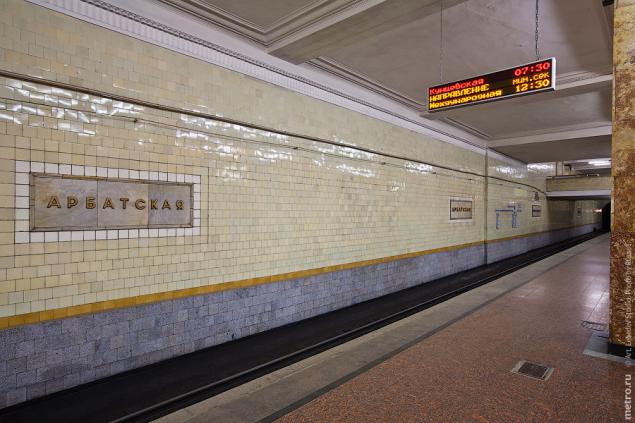
Driving "Arbat" - "Smolensk»
Here, the tunnel was broken air bomb July 23, 1941.
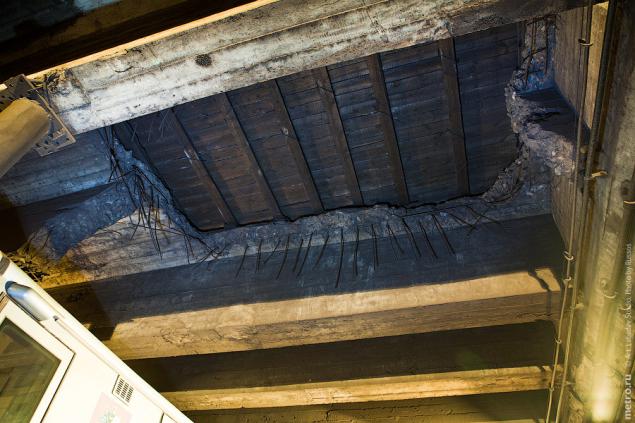
The station "Smolenskaya»
January 15, 2003 to_the_future mailing list [metro] published the following text:
ddyc & gt; Why travel to the walls of Smolensk (Fili). Tiles in the form of honeycombs.
ddyc & gt; Not because of the fact that in the 19th century there was a fair.
Yes indeed. When opening the ground for the construction of Smolensk,
Filevskaya line, found the remains of underground structures
(basement), commercial premises of the fair. In one of them was found
impressive reserves of tiles, and the best preserved
It was a warehouse tiles honeycomb.
At a meeting with Kaganovich, it was decided to accelerate
construction, select the entire items (hand - the good, in working
hands, in those days, the lack of nebylo), and the number of missing
release. Produce did not have to - it was discovered more than a hundred
thousands of pieces of tile. Reserves will last quite a long time and the first time
tiles, as patches to the walls of Smolensk, were released in
1987. Naturally, the Soviet press about this modestly silent,
but there have been discussed the book in which this operation is described
in some detail.
The joke would have remained just a joke, if not later than one guide written in his text about this unfortunate tile. It turned out spectacularly.
In the photo you can see two interesting artifact. It's an old plank stopping trains with the number 6 and the new with the number 4. Since at the PL is now operated only Rusich, who with 4 articulated wagon, then rail is written "4".
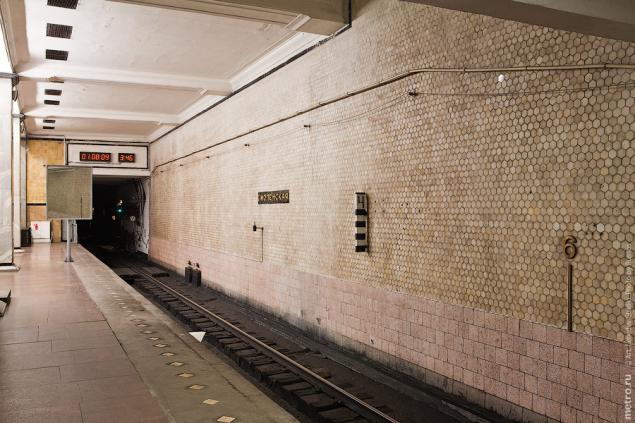
Tunnels for the station "Smolenskaya»
I do not know whether this portal is ready to bridge subway in 1935, as turnover amounted carried out by the Congress, which was in front of the station ... But the walk will finish at the first place it. Ahead - second place!

Source:
People were up all night at the lobbies to be among the first passengers. Change machines and turnstiles was not there. Passengers with tickets were passed in two colors. Red give the right of way to the station "Sokolniki", yellow - back. For tickets to make notes about the time of issuance. The ticket is considered valid for 35 minutes. However, travel outside Moscow time and was not required - the length of the first track composes 11, 6 km.
Let's take a walk through the tunnels and stations of the first stage. It is not my task to show you the architectural beauty of these plants - and so it you already know. I want to tell you about the artifacts of reconstruction or just about unusual things that I have met during the filming.
30 Photo © russos

Deadlocks for the station Sokolniki
Since street Strominka forms at this point a steep bend and did not allow construction of puffins build a second main path along the axis of the way of the station, then by following from "Sokolniki" to "Transfiguration Square" follow train (a rare event for Moscow) with a deviation of the arrow. It is difficult to say whether to use the second in 36 main road, but now we have an unusual configuration deadlocks.

Station "Sokolniki»
At the end of the station are all sorts of service carts for service ceiling and walls. For example, here's the clever design is based on the platform and on the track. A turret can be moved along the guide rails.

Driving "Sokolniki" - "Krasnoselskaya»
The first tunnel of the Moscow subway. The same experimental plot of penetration with a set of rubble. To the left of the opening three zabutovany first mines under construction Metro No. 29. It is for some time been used for natural ventilation, and it remained the number 175. Then built (it is seen more aperture) HS №174, where VOMD installed, and the first VSH zabutovany, retaining its top kiosk that after the construction of another business center has been moved to a new location, and a plaque to him was lost.

Station "Krasnoselskaya»
The peculiarity of the structural schema "Krasnoselskaia" is the location of the columns in a row along the axis of the station, rather than two, as in other similar plants of the first stage. On "Krasnoselsky" I do not forecast a large passenger traffic, so the platform is made narrower. Also right in the station for travel serёdke wall beyond VS №170.

Driving "Krasnoselskaya" - "Komsomolskaya»
Night alignment in tight corners of the station "Komsomolskaya". III station the way is always free, as it is carried out by connection to the depot "North."

A branch of the depot
The portal of the tunnel at the depot "North."

The station "Komsomolskaya»
Station design is unique. To serve a large number of passengers station was designed with passing over the tracks along the buildings balconies, which contributed to a more even distribution of passenger traffic. The width of the station platform level - 16, 8 meters, at balconies - 23 meters. Wide stairs connect the ends of the platform to the lobby. In addition, the station is arranged in the center of the transition bridge between the balconies and staircases to descend to the platform. Overlapping rests on four rows of columns, two rows on the platform portion and one on each of the balconies. Initially, passenger traffic at the station were neatly divided: incoming passengers heading to the balcony and down to the station in the center, go up the mechanical stairs. When the guards were removed, there was pandemonium on the stairs.

Driving "Komsomolskaya" - "Red Gate»
The rail car suddenly drove past. If you look at the ceiling, you can see the border between the two areas. Near us we build mining method, and in the construction of long-distance were using caissons. Ie three sections of tunnel were built on the surface, and then lowered to the design depth.

The station "Red Gate»
In 50 years at the station (as well as in the whole of the first stage) The hermetic locks were installed, resulting in the elimination of two pairs of passes between the side and middle rooms. In the picture you can see the two halves of the gate before closing.

Driving "Red Gate" - "Pure ponds»
For the first phase is characterized by such coupling tunnels and approach ventkanala of mine - round and small.

Station «Chistye Prudy»
During the Great Patriotic War at the station housed offices of the General Staff and Air Defense. The trains did not stop, the platform was cordoned off by passing trains plywood boards and in front of escalators Anteroom reinforced concrete wall was installed to extinguish a shock wave in the case of falling bombs. During the first two months of the war, has not yet been completed and construction work in the new silo to the General Headquarters, studies of Stalin and the Chief of General Staff Shaposhnikov located in underplatform spacing and stations from the first track. The remaining underplatform spacing and the second track and the platform used for and how communication node. When the stopped train traffic, before removing the voltage from the contact rail to the platform first way was fed up, cars which were used for both work and leisure. Furthermore, this compound tunnel to eliminate clogging any unforeseen situations.

Driving "Pure ponds" - "Lubyanka»
Builders started construction on the original site dvuhsvodchatoy station. In order to provide a more powerful cover of Jurassic clays that can protect against the quicksands, vaults Deepen station about 3 meters. By changing the way work is primarily constructed vaults. Already leaving the meeting of the Moscow Committee, each metrostroevtsev saw before him quite a clear picture of the work and knew his place in it.
Quote from the book "How do we build a subway" M .: History of mills and factories, 1935. (Full story about the head station "Dzerzhinsk" (now the "Lubyanka") you can read here.
This book I have read for a long time - approximately in 2000-2001. And in January 2003, I was riding in the cab of Sokolniki line and saw that when following from Chistye Prudy tunnel has a strange configuration in the vicinity of the KGB. At some point, he converted from a round in a horseshoe-shaped, and the roof becomes a few meters higher than necessary. Then a set does "step" and it becomes normal. Apparently, this is a consequence of changes in the project. Ie when the decision was taken to burial station "Lubyanka", the tunnels on the Net ponds have been constructed as a whole. Therefore it was necessary to reconstruct the constructed area to lower the tray to the desired mark.

The station "Lubyanka»
Because of the complex geological conditions of the station was built without a central hall. At some point there was a question, and whether it is necessary to build a plant here, but this is declared inadmissible. At the cost of tremendous efforts, in fierce fight with underground elements, the station was built in the period, although without the central hall. In the 70s it was completed, but the architectural design has been radically changed. It is believed that it was many times worse and homely than it could be. In memory of the original form at the ends of travel station tunnels to keep the old design.

Driving "Lubyanka" - "Okhotny Ryad»
Metal structures or so-called hermetic locks. It was established after the war. Ie initially in the first place they are not becoming, but was subsequently held total reconstruction of stations and spans to install shutters.

The station "Okhotny Ryad»
The basis of the method adopted was the development of the station put the so-called "German method." Originally constructed the wall, and then they were planted vaults station. First there were the extreme wall erected along the building of the hotel and home service stations. These barriers have separated all forthcoming work on buildings, protected bases from possible displacement of soil. Once the foundations were built for future piers and pylons themselves. The walls were built not continuous arrays and small parts, which are then connected to each other to prevent simultaneous disclosure of large volumes of voids in the heart of the city. All underground space was dissected countless galleries with a total length of several kilometers. For the first time the station has been used outside Okleechnaya insulation, which was later spread across the track.

Driving "Okhotny Ryad" - "Lenin Library»
At Sokolniki line utility branch (CER) Alexandrovsky Garden consisted of two ways in the two tunnels. They were built to launch the first phase in 1935. In the mid-90s during the construction of the shopping center "Okhotny Ryad" under the Manege Square, it was decided to disassemble one tunnel that branches off on the way II, as he found himself in the body of the shopping complex. Turnouts were dismantled, but the camera stayed Congresses.

The station "Lenin Library»
The only station in the first stage, built vaulted. The choice of the type of plant affected as the ground conditions, and the need to make the work of the closed method, so as not to disrupt traffic. The station was built in extremely cramped conditions due to the small width of the passage between the houses that require the smallest width of the underground workings. According to unverified information, shortly after the opening on the platform it was a parquet floor, but it lasted a very short time.

Driving "Lenin Library" - "Kropotkinskaya»
Vibration Mount was established several years ago to protect the Museum of Fine Arts from vibration. On the right photo you can also see ventshahtu and fan. It was he scared buzzing at the entrance to Kropotkin with the reversal of the Library. Rather, it was built later, in the reconstruction of ventilation throughout the first phase.

Station «Kropotkinskaya»
For a long time the station was only one way in ground lobby on Gogol Boulevard, erected by the architect SM Kravets. The lobby is easy semicircular building of a series of circular columns in the form of an arch, which opens the entrance to the Gogol Boulevard. A wide granite staircase leads to the ticket hall, whose walls are lined with marblitom (glass plates milky). Unfortunately, the ticket hall has not escaped the barbaric replacement of wooden frames with plastic windows.

Driving "Kropotkinskaya" - "Park of Culture»
A typical two-way tunnels fine bedding.

The station "Cultural Park»
March 29th, 2010 at the station "Lubyanka" and "Park Kultury" Sokolniki line was exploded two suicide bombers. The blast killed 40 people and injured 88. Even a week later at the station carrying flowers.

Deadlocks for the station "Park Kultury»
Corner safety.

The service branch "Okhotny Ryad" - "Alexandrovsky Garden»
Left out of CERs on the I path of Sokolniki line. Next was the shooter and the only blind intersection on the main routes in the Moscow metro. The tunnel led to the way the SL II. Next, double-track tunnel turns into two single-track and leads to the station "Revolution Square."

The station "Alexandrovsky Garden»
The station is unusual for the Moscow subway side-boarding platforms. This is explained by tracing tunnels in the narrow space between the Manezh building and Kutafia tower of the Kremlin. In the original draft of the first stage all the stations were designed with an island platform. But here, at the walls of the Kremlin, to accommodate the island platform would require dilution tunnels that would cut into the foundations of an arena and Kutafia tower. The slightest residue Manezh would violate the unique trusses. At the urging of Professor oversaw the construction of VL Nicolai and categorical demand commandant of the Kremlin, is responsible for the safety of the walls and towers, the project has been changed, the station adjacent to the path laid in a double-track tunnel. In the picture are the same mysterious tunnels, which, as many believe, lead to the Kremlin.

Driving "Alexandrovsky Garden" - "Arbat»
Cross Congress and VSH №350

The station "Arbat»
In 1953, simultaneously with the opening of deep Arbat radius (of the Arbat-Pokrovskaya line), small radius from the station Arbat "Street. Comintern "(now" Alexandrovsky Garden ") to the station" Kiev "was closed. The station hall "Arbat" was used, according to some, as a warehouse. Again, this section opens with the launch Filevskaya line in November 1958.

Driving "Arbat" - "Smolensk»
Here, the tunnel was broken air bomb July 23, 1941.

The station "Smolenskaya»
January 15, 2003 to_the_future mailing list [metro] published the following text:
ddyc & gt; Why travel to the walls of Smolensk (Fili). Tiles in the form of honeycombs.
ddyc & gt; Not because of the fact that in the 19th century there was a fair.
Yes indeed. When opening the ground for the construction of Smolensk,
Filevskaya line, found the remains of underground structures
(basement), commercial premises of the fair. In one of them was found
impressive reserves of tiles, and the best preserved
It was a warehouse tiles honeycomb.
At a meeting with Kaganovich, it was decided to accelerate
construction, select the entire items (hand - the good, in working
hands, in those days, the lack of nebylo), and the number of missing
release. Produce did not have to - it was discovered more than a hundred
thousands of pieces of tile. Reserves will last quite a long time and the first time
tiles, as patches to the walls of Smolensk, were released in
1987. Naturally, the Soviet press about this modestly silent,
but there have been discussed the book in which this operation is described
in some detail.
The joke would have remained just a joke, if not later than one guide written in his text about this unfortunate tile. It turned out spectacularly.
In the photo you can see two interesting artifact. It's an old plank stopping trains with the number 6 and the new with the number 4. Since at the PL is now operated only Rusich, who with 4 articulated wagon, then rail is written "4".

Tunnels for the station "Smolenskaya»
I do not know whether this portal is ready to bridge subway in 1935, as turnover amounted carried out by the Congress, which was in front of the station ... But the walk will finish at the first place it. Ahead - second place!

Source:
Tags
See also
Moscow Metro (42 photos)
Where sleeping train
Best photos of 2010 version of Russian reporter
Moscow Metro. As a beginner.
Moscow (70 photos)
Powerful explosions at intervals of half an hour
Moscow subway inside
Upotevshie all countries - unite!
Bulb Ilyich

















